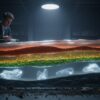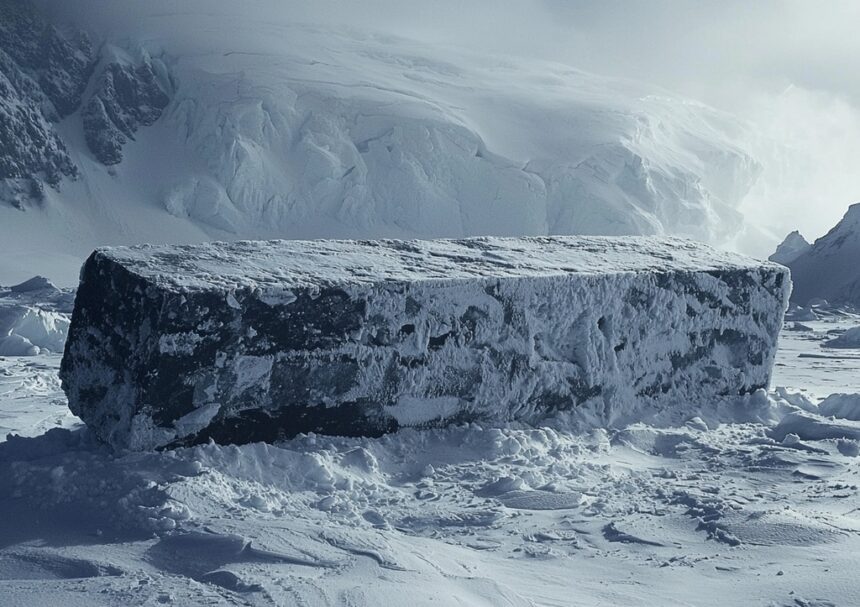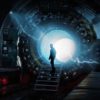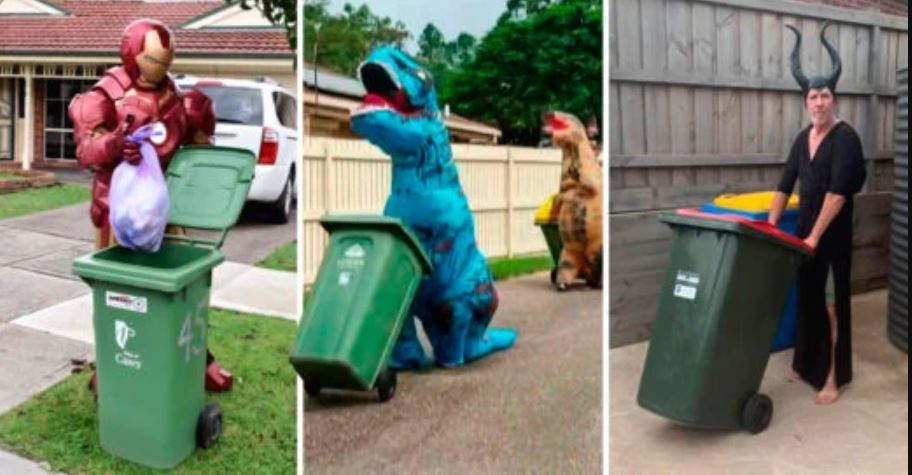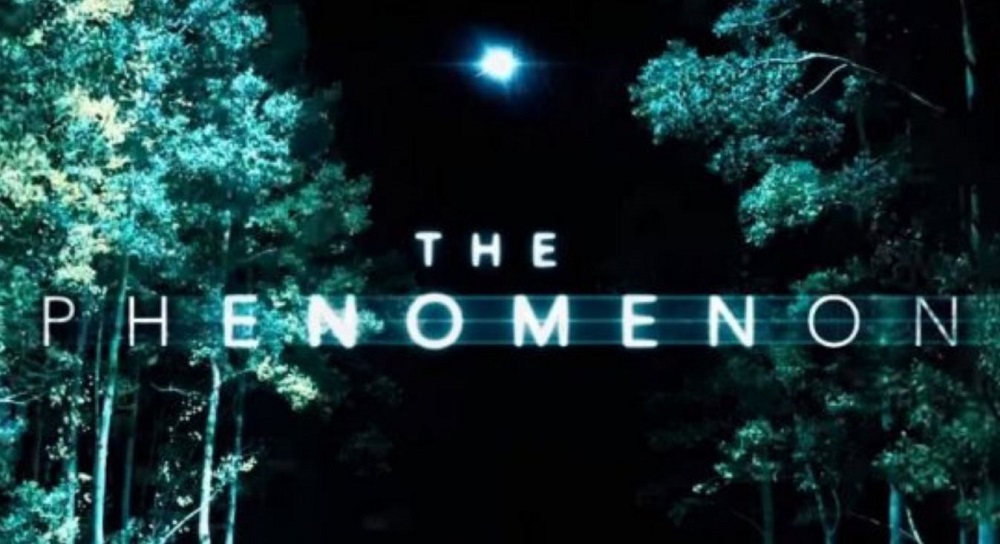In the heart of Antarctica’s icy wasteland, where the eternal cold silences footsteps and breath, a clandestine team of scientists from the United States, Russia, China, and India embarked on a classified mission. Their objective: to investigate a discovery so extraordinary it defied explanation. Led by American expedition leader Robert Smith, alongside Russian geophysicist Alexei Volkov, Indian physicist Nihal Roy, and Chinese engineer Cao Lin, the team ventured into one of Earth’s most remote regions, with only a select few on the mainland privy to their progress.
Their discovery—four mysterious black sarcophagi—stood out starkly against the frozen landscape. Polished to a mirror-like smoothness, these objects gleamed under the dim light of lanterns, their unusual shapes and flawless craftsmanship suggesting an origin far beyond human understanding. The sarcophagi appeared as though carved with laser precision, an anomaly in a region untouched by modern technology. Even more perplexing, they radiated an inexplicable warmth despite the subzero temperatures of Antarctica.
Eerie Sounds and Unsettling Phenomena
The first night at the research station brought unsettling events. Robert Smith, unable to sleep, awoke at 3 a.m., gripped by the sensation of being watched. A faint, low rumble emanated from the depths of the station, though the devices analyzing the sarcophagi remained silent. Venturing to the hangar where the objects were stored, he found his colleagues—Volkov, Roy, and Lin—already there, equally disturbed by the sound.
“A low vibration, like the ground itself is humming,” Nihal Roy confirmed, his voice unsteady. The team approached the sarcophagi, and a single drop of water, likely from melting ice, fell onto one of the objects. Instantly, the sarcophagus trembled, emitting a haunting, low-frequency hum that sent chills through the group. “Is it the ground, or the box itself?” Cao Lin gasped, her skepticism giving way to awe.
Robert touched the surface, noting its unnatural warmth. “Warm? In minus ten degrees?” Alexei Volkov muttered, staring at the object as if it were a mirage. The sarcophagi’s ability to produce sounds and maintain heat in such extreme conditions suggested they were not mere relics but potentially active, responsive artifacts.
The Chilling Message Revealed
Determined to uncover the sarcophagi’s secrets, the team attempted to open one of the containers. The lid resisted physical force and tools, but when a cutter was applied, a low, moaning sound filled the air, and the lid opened of its own accord. Inside lay a cylindrical object made of an unknown metal, its surface etched with intricate patterns resembling runes, Morse code, or an alien script. Like the sarcophagus, the cylinder was hot to the touch, as if it had just been forged.

“It knows we’re here,” Nihal whispered, his eyes wide with fear. “This is a signal, a message.”
As Robert reached for the cylinder, Alexei stopped him, warning of potential radiation or biological hazards. At that moment, the laboratory’s monitor flickered to life, displaying a message in every known language:
“DO NOT WAKE UP THAT WHICH SLEEPS. OUR SLEEP SHOULD BE ETERNAL.”
The message sent a wave of dread through the team. In the days that followed, the sarcophagi continued to interact with their environment. Electronic devices malfunctioned, the temperature in the storage room fluctuated inexplicably, and team members reported vivid, disturbing dreams. The station’s computer, tasked with analyzing data, began receiving additional messages: “NOTHING. NO ONE. NEVER.” and “WE HAVE TO STAY THERE.”
A Cosmic Warning
The most alarming message appeared days later: “LIGHTHOUSE-PROTECTION. SIGNAL IS DROWNED OUT. THEY SHOULD NOT KNOW ABOUT THE EXISTENCE OF THIS PLANET. THEY DON’T HAVE TO UNDERSTAND THE COORDINATE POINT. GLOBAL ANNIHILATION IN THE EVENT OF SIGNAL LEAKAGE. THE BEACON MUST REMAIN IN PLACE.” The team grappled with its implications. Cao Lin interpreted it as a warning that the sarcophagi were beacons designed to shield Earth from detection by an unknown cosmic force. “If ‘THEY’ detect this signal, all life could end,” she said gravely.
Robert speculated that the sarcophagi were part of a security system, concealing Earth’s existence to protect it from annihilation. Alexei, more pragmatic, questioned whether humanity should risk uncovering truths that could invite destruction.
“Do we really want to know what’s out there?” he asked. “What if ‘THEY’ sweep away everything we’ve built?”
The team debated the nature of this unseen force. Was it an extraterrestrial civilization intent on preventing life’s expansion? A failsafe left by an ancient, advanced society? Or something far more incomprehensible? The messages suggested Earth was in deliberate isolation, its survival hinging on the sarcophagi remaining undisturbed.
Scientific Theories and Ethical Dilemmas
The sarcophagi’s advanced craftsmanship and anomalous properties have sparked diverse theories. Some scientists propose they are relics of a prehistoric civilization with technology surpassing modern capabilities. Others entertain the possibility of extraterrestrial origins, citing the cryptic messages and unknown materials as evidence of alien intervention. More conservative hypotheses suggest a secretive modern experiment, though no known technology matches the sarcophagi’s characteristics.
The discovery has also raised ethical questions. The ominous warnings have led some to advocate halting further exploration until the risks are better understood. Others argue that the pursuit of knowledge justifies the potential dangers, emphasizing the sarcophagi’s potential to rewrite history or reveal cosmic truths. For now, the team faces a moral quandary: continue probing or heed the warnings and leave the mystery buried.
A Decision to Conceal
Faced with the possibility of catastrophic consequences, the team made a unanimous decision: the sarcophagi would be reburied in Antarctica’s icy depths, hidden from discovery for millennia. Their official report described the objects as rare granite monoliths, downplaying their significance to avoid scrutiny. The scientists agreed that the risk of unleashing an unknown force—or alerting “THEY” to Earth’s existence—was too great.

Yet, thousands of light-years away, in the pitch-black void of space, something stirred. A faint signal, originating from a remote corner of the Milky Way, reached a colossal, unseen entity. Whether this was a fleeting anomaly or the beginning of something far greater remains unknown.
Implications for Humanity
The black sarcophagi of Antarctica represent one of the most profound mysteries in modern science. Their existence challenges our understanding of history, technology, and humanity’s place in the cosmos. Whether they are remnants of a lost civilization, extraterrestrial beacons, or guardians of an ancient secret, they hold the potential to reshape our worldview.
As the scientific community plans cautious future expeditions, using advanced imaging to probe Antarctica’s ice without disturbing the sarcophagi, the world watches with a mix of curiosity and trepidation. The chilling messages serve as a reminder that some truths may come at a cost too great to bear. For now, the sarcophagi remain silent, their secrets locked beneath the ice, waiting for a time—or a mistake—that may awaken what should remain asleep.



